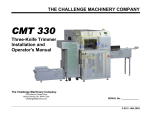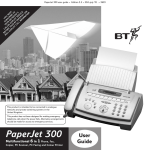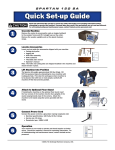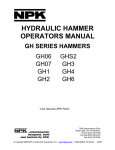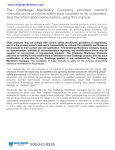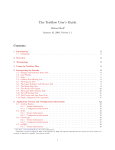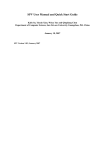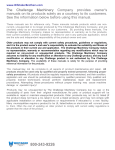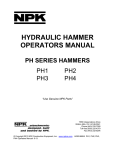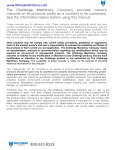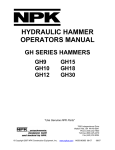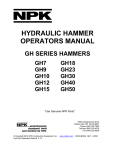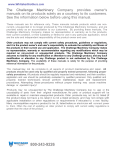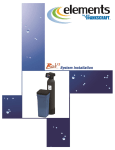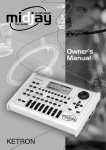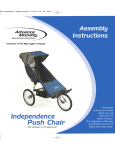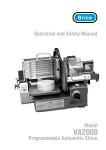Download The Challenge Machinery Company provides owner`s manuals on
Transcript
The Challenge Machinery Company provides owner's manuals on its products solely as a courtesy to its customers. See the information below before using this manual. These manuals are for reference only. These manuals include products which are noncurrent, unsupported or no longer produced by The Challenge Machinery Company, and are provided solely as an accomodation to our customers. By providing these manuals, The Challenge Machinery Company makes no representation or warranty as to the products, their current condition, or their suitability or fitness for use in any particular application, which are the sole and independent responsibility of the product owner and user. Older products may not comply with current safety procedures, guidelines or regulations, and it is the product owner's and user's responsibility to evaluate the suitability and fitness of the products in their current use and application. The Challenge Machinery Company makes no representation, warranty or recommendation regarding any modifications which may be required on non-current or unsupported products. The Challenge Machinery Company assumes no liability for any modification or alteration to any Challenge product, and any such modification or alteration to any Challenge product is not authorized by The Challenge Machinery Company. The availability of these manuals is solely for the purpose of providing reference information for the products. This manual may not be complete in all aspects of product maintenance and repair. All products should be used only by qualified and properly trained personnel, following proper safety procedures. All products should be regularly inspected and maintained, and their condition, application and use should be periodically evaluated by qualified personnel. Only qualified and properly trained technicians should perform maintenance, repair and replacement procedures. Attempting these procedures without proper training may cause machine damage or operator injury! Products may be unsupported by The Challenge Machinery Company due to age or the unavailability of parts from their original manufacturer. No parts or product support will be available to repair or maintain unsupported products. Older products may not be UL listed (if the product does not have a UL label it is not a listed product), and may not comply with applicable installation or other regulations or requirements if relocated to a new facility. Many municipalities require a product to be UL listed before an electrician will connect power to them. Often the cost of updating an older product to comply with current safety regulations is greater than the value of the product. THE CHALLENGE MACHINERY COMPANY CMT 330 Three-Knife Trimmer Installation and Operator's Manual The Challenge Machinery Company 6125 Norton Center Drive Norton Shores, MI 49441 USA ChallengeMachinery.com SERIAL No.: _____________ F.033 / JAN 2003 NOTICE Service documentation is supplied to Challenge external customers for informational purposes only. Service documentation is intended for use by certified, producttrained personnel only. Challenge does not warrant or represent that such documentation is complete, nor does Challenge represent or warrant that it will notify or provide to such customer any future changes to this documentation. Customer performed service of equipment may affect the warranty offered by Challenge with respect to such equipment. If the customer services this equipment, modules, components or parts thereof, the customer releases Challenge from any and all liability for the customer actions, and the customer agrees to indemnify, defend and hold Challenge harmless from any third party claims which arise directly or indirectly from such service. Prepared by: The Challenge Machinery Company 6125 Norton Center Drive Norton Shores, MI 49441 USA Phone: 231.799.8484 Fax: 231.798.1275 ChallengeMachinery.com ©2002-2011 by The Challenge Machinery Company. All rights reserved. Challenge® is a registered trademark of The Challenge Machinery Company. 01/03 CMT 330 Three Knife Trimmer ii Contents 5.4 Rectangular Crease Lines........................ 5-3 5.5 Linear Crease Lines ................................. 5-3 5.6 Draw ......................................................... 5-3 5.7 All Sheets Not Cut.................................... 5-4 5.8 Book Not Square...................................... 5-4 Contents Description Page 1 Introduction 1-1 1.1 Warranty Information ................................1-2 1.2 Warning Label Definitions .........................1-3 1.3 Note Definitions.........................................1-3 1.4 Safety ........................................................1-3 1.5 Power Lockout Procedure.........................1-4 1.6 Packing List...............................................1-5 1.7 Specifications ............................................1-8 1.8 General Locations.................................. 1-10 1.9 Site Specifications.................................. 1-17 2 Installation Guide 2-1 2.1 Shipping Claims ........................................2-2 2.2 Unpacking .................................................2-2 2.3 Moving.......................................................2-2 2.4 Option Setup .............................................2-2 2.5 Power Hookup...........................................2-8 2.6 Air Hookup ................................................2-9 2.7 Cleaning ....................................................2-9 3 Operator's Guide 3-1 3.1 Programming.............................................3-2 3.2 User Interface Map ...................................3-5 3.3 Power up ...................................................3-6 3.4 Improper Wiring.........................................3-6 3.5 Run Mode..................................................3-6 3.6 Job Mode ..................................................3-7 3.7 Maintenance Mode ...................................3-9 3.8 Status Messages ................................... 3-13 3.9 Example Job .......................................... 3-16 3.10 Serial Data ........................................... 3-18 4 Routine Tasks 4-1 4.1 Waste Bins ................................................4-2 4.2 Cut Stick / Cut Plates ................................4-2 4.3 Knives .......................................................4-4 4.4 Check Pressure Switch.............................4-8 4.5 Safety Systems Check..............................4-9 5 Book Quality 5-1 5.1 Burr Marks.................................................5-2 5.2 Jagged Bottom Cover ...............................5-2 5.3 Burr Marks/Jagged Cover .........................5-2 01/03 CMT 330 Three Knife Trimmer iii Contents Notes: 01/03 CMT 330 Three Knife Trimmer iv Contents 1 Introduction Section Contents Introduction TITLE PAGE 1.1 Warranty Information ................................1-2 1.2 Warning Label Definitions .........................1-3 1.3 Note Definitions.........................................1-3 1.4 Safety ........................................................1-3 1.5 Power Lockout Procedure.........................1-4 1.6 Packing List...............................................1-5 1.6.1 Basic Machine/Options....................... 1-5 1.6.2 Standard Accessories ........................ 1-6 1.6.3 Consumables...................................... 1-7 1.7 Specifications ............................................1-8 1.7.1 Book Size Chart ................................. 1-9 1.8 General Locations.................................. 1-10 1.8.1 Front Views....................................... 1-10 1.8.2 Back View......................................... 1-11 1.8.3 Exit Conveyor ................................... 1-12 1.8.4 In-feed Conveyor.............................. 1-13 1.8.5 Tilt In-feed Conveyor ........................ 1-14 1.8.5 Tilt In-feed Conveyor ........................ 1-14 1.8.6 Elevator ............................................ 1-15 1.8.7 Hand-feed Conveyor ........................ 1-16 1.9 Site Specifications.................................. 1-17 1.9.1 In-line Option 1 ................................. 1-17 1.9.2 In-line Option 2 ................................. 1-18 1.9.3 Stand-alone Option .......................... 1-19 The introduction section of this manual is intended to provide installers and operators with basic information. Safety recommendations are made, and machine options and specifications are listed. 01/03 CMT 330 Three Knife Trimmer 1-1 Introduction 1.1 Warranty Information READ THIS MANUAL BEFORE OPERATING! Follow all precautions and instructions. For parts and service contact the Authorized Challenge Dealer from whom the machine was purchased. Always give the SERIAL NUMBER and MODEL of your machine to ensure the correct parts are sent. RECORD YOUR MACHINE SERIAL NUMBER in the space provided on the front cover of this manual. Fill in the warranty card accompanying this manual and return it DIRECTLY TO CHALLENGE. If you bought a used machine, it is important to have the following information on record at Challenge. Copy this page, fill in the information and send it care of The Challenge Service Department, 6125 Norton Center Drive • Norton Shores • MI 49441. * INSTALLATION INFORMATION * Model: CMT 330 Serial No.: Company Name: * WARRANTY INFORMATION * PLEASE REVIEW THE ENCLOSED WARRANTY INFORMATION SHEET The letters in the following diagram correspond to the accuracy adjustment values listed in the Installation Information table at the right. Address: City: It is very important that you read and understand the conditions outlined in the Warranty Information Sheet attached to the outside of the shipping container of your machine. The Warranty Information Sheet must be filled out completely and returned to THE CHALLENGE MACHINERY COMPANY in order for the warranty to be issued for this machine. State/Province: ZIP Code A________ B________ Phone No.: Date Installed: Dealer Name: C________ Dealer City: Accuracy Adjustment Values A= inches B= inches C= inches 01/03 CMT 330 Three Knife Trimmer 1-2 Warranty Information 1.2 Warning Label Definitions 1.3 Note Definitions 1.4 Safety Warning labels are posted throughout the machine to indicate areas where physical injury may occur. The formats of three specific types of notes found throughout this manual indicate the level of danger or importance associated with the task presented. The format of warning notes, caution notes, and regular notes imply a certain level of danger. The following examples give a description. Associate the text format with its level of danger or importance. Before installing or operating any equipment, it is important to take precautions. Read and thoroughly understand the safety precautions outlined below. Read the instruction manual. The instruction manual should be read and understood before operating this machine. • • Do not operate with more than one person! One person only should operate this machine at a time. Warning Definition: Cut / Crush Hazard! Do not operate with covers removed. Do not disable safety devices. A warning indicates an operating or maintenance procedure, practice, or condition that, if not strictly observed, could result in injury or loss of life. Crush Hazard! Do not operate with covers removed. Do not disable safety devices. Caution Definition: • WARNING Crush / Entanglement Hazard! Do not operate with covers or guards removed. Electrical Shock Hazard! Disconnect power before removing cover. • CAUTION A Caution indicates an operating or maintenance procedure, practice, or condition that, if not strictly observed could result in damage to, or destruction of, equipment. • • • Note Definition: • Note: A regular note indicates an operating or maintenance procedure, practice, or condition that is necessary to accomplish a task efficiently. Electrical Shock Hazard! Disconnect power before removing cover. • • This machine is designed for oneperson operation. Never operate the machine with more than one person. Safe use of this machine is the responsibility of the operator. Use good judgment and common sense when working with and around the machine and its accessories. Read and understand all instructions thoroughly before using the machine. If questions remain, contact your Authorized Challenge Dealer. Failure to understand the operating instructions may result in personal injury. Only trained and authorized individuals should operate this machine. Only trained and authorized service technicians should service this machine. Do not alter safety guards or devices. They are there for your protection. Severe laceration or dismemberment may result if safety devices are altered. Disconnect power and lock out before performing any maintenance. See Section 1.5 , Power Lockout Procedure. Observe all caution and instruction labels on this machine. Be extremely careful when handling and changing knives. Severe lacerations or dismemberment could result from careless handling procedures. Perform the Safety Systems Check given on page 4-9 before each shift begins. 01/03 CMT 330 Three Knife Trimmer 1-3 Warning Label Definitions • • • Keep all conveyors and elevator accessories clear of foreign objects. Do not manually place foreign objects within the machine. Cutting anything other than qualifying perfect bound books could result in serious damage to the machine and create safety hazards. A qualifying perfect bound book will fall into the size range described in the specifications on page 1-8. Make sure all applicable accessories are securely bolted to the main machine. Tip hazards may result from unsecured accessories. If the machine operates abnormally, consult a Challenge authorized service agent. 1.5 Power Lockout Procedure For maximum safety while making ADJUSTMENTS or REPAIRS to your machine, lock out the main power disconnect switch. The switch should be moved to the OFF position and a padlock securely fastened through the loop. The person adjusting or servicing the machine should hold the key. Figure 1-1. Main Power Disconnect 01/03 CMT 330 Three Knife Trimmer 1-4 Power Lockout Procedure 1.6 Packing List Compare the contents of the crate against the following lists and the packing slip to be sure all items are included with your shipment. 1.6.1 Basic Machine/Options This parts list includes the basic machine and any accessories that may have been ordered with the machine. Part Number CMC-330 In-line Option 1 56401 56421 In-line Option 2 56600 56421 Stand-alone Option 56416 Exit Option 56420 Description CMT 330 Basic Machine Accessory Options In-line (shown above) In-feed Conveyor Cooling Elevator In-line with Tilt In-feed Conveyor Tilt In-feed Conveyor Cooling Elevator Stand Alone Hand-feed Conveyor Fixed (shown above) Exit Conveyor Qty. 1 1 1 1 1 1 1 01/03 CMT 330 Three Knife Trimmer 1-5 Packing List 1.6.2 Standard Accessories The following list contains pre-installed, standard accessories for the CMT 330. Item 1 2 3 4 5 6 7 8 Part Number 5064 56028 56143 56246 56303 56304 H-6910-605 W-180 Description Cut Stick Puller Knife Lifter Waste Bin Knife (scabbard not shown) Cut Stick Cut Plate Knife Bolt- 3/8-16 x 5/8 BHCS 7/32" T-Handle Hex Wrench Qty. 1 1 3 6 1 2 18 1 01/03 CMT 330 Three Knife Trimmer 1-6 Packing List 1.6.3 Consumables The CMT 330 uses the following consumable items. Part Description Qty. Frequency E-967-1 56527-4700 56523-1000 SU-30-103 SU-30-104 56228 56181 56181-1 56178 56246 56303 56304 LAMP UHMW TAPE (TABLE) UHMW TAPE (JOG) GREASE (EXT. PRESS.) GREASE (RYKOTAC EP) FACE PAD LEFT CLAMP PAD RIGHT CLAMP PAD CENTER PAD KNIVES (SET OF 3) CUT STICK CUT PLATE 6 10,000 hrs 2 1 yr. 2 1 yr. BULK 1 wk. BULK each knife change 1 6 mo. 1 6 mo. 1 6 mo. 1 6 mo. 1 5000 books 1 rot. 1000, change 8000 books 2 rot. 1000, change 4000 books The following consumables are found in Oil Change Kit, K-56040. Part Description 56041 H-227-1 S-1991-3 FILTER ELEMENT (AIR) FILTER ELEMENT (OIL) GRADE 46 HYD. FLUID Qty. Frequency 1 1 1 1 yr. 1 yr. 1 yr. 01/03 CMT 330 Three Knife Trimmer 1-7 Packing List 1.7 Specifications WARNING The CMT 330 was designed specifically for use with the Challenge in-feed and exit accessories listed in this table. If any other accessories are used, it is the purchaser's responsibility to comply with ANSI B65.4 Safety Standard for Three-knife Trimmers. Failure to comply with this standard could result in personal injury or death. CAUTION The CMT 330 was specifically designed to trim perfect bound books only. It should not be used for trimming other materials. Trimming other materials with the CMT 330 may result in safety hazards or damage to the machine. For trimmable book sizes, see section 1.7.1 . NOTE: Challenge reserves the right to make changes to any product or specification without notice and without incurring responsibility to existing units. Description US Units Metric Units Perfect bound books only Start book (max.) 9.5 x 12.5 in. 241 x 317.5 mm Start book (min. bottom cover) 6.75 x 7 171.4 x 177.8 mm Finish book (min.) 4.125 x 5.875 in. 104.8 x 149.2 mm Face trim (max.) 5.5 in. 140mm Book thickness range 0.048-2.000 in. 1.22-50.8 mm Minimum Trim 0.125 in. 3.2 mm CMT 330 Basic Machine Width 34.5 in. 876 mm Depth 84 in. 2134 mm Height 61 in 1549 mm Net Weight 2540 lb. 1140 kg Shipping Weight 2850 lb. 1300 kg Floor Loading 60 PSI 414 kPa Waste Bin Capacity 3 @ 14.75 gal. per bin 3 @ 55.8 L per bin Oil Capacity 5 gal. 19 L Air Consumption 5 CFM @ 80 PSI 142 LPM @ 5.5 Bar Knife Re-grind 1/4 in. 6.4 mm 60 Hz Requirements 208/230 V, 25 A, 3 phase 50 Hz Requirements 380/415 V, 10 kW, 3 phase, 12 A Memory 99 jobs Time to change book size 15 sec. Throughput up to 400 books/hr. 56401 Basic In-feed Conveyor Depth 12.14 in. 308.4 mm Width 35.4 in. 876 mm Height 17.5 in. 445 mm 56420 Exit Conveyor Depth 12.14 in. 308.4 mm Width 47 in. 1194 mm Height 39.5 in. 1003 mm 56421 Cooling Elevator Depth 21.5 in. 546 mm Width 37.03 in. 941 mm Height 45.5 in. 1156 mm 56600 Tilt In-feed Conveyor Depth 28.62 in. 727 mm Width 39.38 in. 1000 mm Height 26 in. 660 mm Mates w/ binder exit heights 17.5-25.5 in. 445-648 mm 01/03 CMT 330 Three Knife Trimmer 1-8 Specifications 1.7.1 Book Size Chart Figure 1-3 can be used to determine if a specific book layout can be trimmed using the CMT 330. From Figure 1-2, see that (x) is the bottom trim and (h) is the height of the book. The book size must fall within the shaded region of the chart but never exactly on the sloped line. The CMT 330 software will not allow a book to be cut outside this range. The operator should be aware of these size constraints before books are printed. The CMT 330 will not allow only one top or bottom edge to be trimmed. Figure 1-3. Trimmable Book Sizes Figure 1-2. Book Terminology 01/03 CMT 330 Three Knife Trimmer 1-9 Specifications 1.8 General Locations Become familiar with general machine locations. This manual frequently refers to these locations. In order to understand the instructions presented, it is necessary to have a working knowledge of machine locations. Note: The word "rear" refers to the general direction closer to the back end of the machine. "Back" refers only to the backside of the machine. 1.8.1 Front Views The front views shown in Figure 1-4 and Figure 1-5 locate the front, back, right, and left sides of the machine. Remember these references while reading instructions in this manual. Refer back to these figures as necessary. Figure 1-4. Right Front View Figure 1-5. Left Front View 01/03 CMT 330 Three Knife Trimmer 1-10 General Locations 1.8.2 Back View Important locations at the back of the machine are shown in Figure 1-6. Figure 1-6. Back View 01/03 CMT 330 Three Knife Trimmer 1-11 General Locations 1.8.3 Exit Conveyor Part Number: 56420 Important locations are shown in Figure 1-7. Figure 1-7. Exit Conveyor Locations 01/03 CMT 330 Three Knife Trimmer 1-12 General Locations 1.8.4 In-feed Conveyor Part Number: 56401 Important locations are shown in Figure 1-8. Figure 1-8. In-feed Conveyor Locations 01/03 CMT 330 Three Knife Trimmer 1-13 General Locations 1.8.5 Tilt In-feed Conveyor Part No.: 56600 Important locations are shown in Figure 1-9. Figure 1-9. Tilt In-feed Conveyor 01/03 CMT 330 Three Knife Trimmer 1-14 General Locations 1.8.6 Elevator Part Number: 56421 Important locations are shown in Figure 1-10. Figure 1-10. Elevator Locations 01/03 CMT 330 Three Knife Trimmer 1-15 General Locations 1.8.7 Hand-feed Conveyor Part Number: 56416 Important locations are shown in Figure 1-11. Figure 1-11. Hand-feed Conveyor Locations 01/03 CMT 330 Three Knife Trimmer 1-16 General Locations 1.9 Site Specifications The installation site must have adequate space and utilities to support the trimmer with its setup options. It requires a supply of compressed air and electricity. Refer to section 1.7 Specifications on page 1-8 to verify that the site can accommodate these requirements. Use the following figures to determine floor space requirements for the option to be installed. 1.9.1 In-line Option 1 This in-line option is used when automated transport of books from a binder to the trimmer is required and book size changes are infrequent. It includes the CMT 330 basic machine, two conveyors, and an elevator. See Figure 1-12 for space requirements. Note the locations of the air and power hook-up locations. Air and power lines should be dropped from the ceiling in order to have clear access to the waste bins using a rolling cart. Figure 1-12. In-line Option 1 01/03 CMT 330 Three Knife Trimmer 1-17 Site Specifications 1.9.2 In-line Option 2 This in-line option is used when automated transport of books from a binder to the trimmer is required and book size changes are frequent. It includes the CMT 330 basic machine, two conveyors, and an elevator. See Figure 1-13 for space requirements. Note the locations of the air and power hook-up locations. Air and power lines should be dropped from the ceiling in order to have clear access to the waste bins using a rolling cart. Figure 1-13. In-line Option 2 01/03 CMT 330 Three Knife Trimmer 1-18 Site Specifications 1.9.3 Stand-alone Option The stand-alone option is used when books are fed to the trimmer by hand. It includes the CMT 330 basic machine and two conveyors. See Figure 1-14 for space requirements. Note the locations of the air and power hook-up locations. Air and power lines should be dropped from the ceiling in order to have clear access to the waste bins with a rolling cart. Figure 1-14. Stand Alone Option 01/03 CMT 330 Three Knife Trimmer 1-19 Site Specifications NOTES: 01/03 CMT 330 Three Knife Trimmer 1-20 Site Specifications 2 Installation Guide Section Contents Introduction TITLE PAGE 2.1 Shipping Claims ........................................2-2 2.2 Unpacking .................................................2-2 2.3 Moving.......................................................2-2 2.4 Option Setup .............................................2-2 2.4.1 In-line Option 1 ................................... 2-3 2.4.2 In-line Option 2 ................................... 2-6 2.4.3 Stand-alone Option ............................ 2-6 2.5 Power Hookup...........................................2-8 2.5.1 Power Hookup Procedure .................. 2-8 2.6 Air Hookup ................................................2-9 2.7 Cleaning ....................................................2-9 The installation guide provides information and instructions essential to the proper setup of each of the CMT 330 and its accessory options. These applications include one option for in-line operation and one option for stand-alone operation. 01/03 CMT 330 Three Knife Trimmer 2-1 Installation Guide 2.1 Shipping Claims The CMT 330 has been packed to prevent damage during shipment. Claims for damage or loss are the responsibility of the recipient. Inspect all shipments as soon as they are received. If there is any noticeable damage, note it on the freight bill. Visual and/or hidden damage must be reported to the claims department of the carrier within 15 days. Contact your dealer if you need any assistance. Check the contents of the crate against both the packing list on page 1-5 and the freight bill. Make sure there are no missing items. 2.2 Unpacking Remove the packing materials and four lag bolts. One lag bolt is located in the frame, behind each of the lower side doors as shown in Figure 2-1. 2. Using a 9/16" open-ended wrench, remove the lag bolts from the two front locations shown in Figure 2-1. 3. Pull open the two lower rear doors and remove the waste bins. 4. Remove the two lag bolts from the two rear locations shown in Figure 2-1. 5. Reinstall the waste bins and close the rear doors. It may be necessary to raise the six leveling pads in order to roll the machine. A pad is located under each corner of the machine. Each of the remaining two pads is located under the middle of each side of the machine. Using either a 3/4" open-ended wrench or an adjustable wrench, turn the leveling pad counterclockwise to raise it. 6. Reinstall the two front side doors. Use a forklift to remove the machine from the skid and place it as close as possible to its installation location. The machine has accessory power cables and air hoses wrapped-up and placed inside the machine. Be careful not to pinch or entangle these in the forks while lifting. Figure 2-3. Leveling Pads Push the CMT 330 into position. Do not lower the leveling pads at this time. Its final position may require slight adjustment depending upon the setup. 2.4 Option Setup The CMT 330 can be used either in-line with a perfect binder or as a stand-alone three knife trimmer. The following table lists the accessories required for each application. Figure 2-2. Fork Location for Lifting 2.3 Moving Figure 2-1. Lag Bolt Locations Remove Lag Bolts 1. Remove four screws from each of the two front side doors using a 1/8" hex wrench. Once the machine is near its final location, it can be rolled into place. WARNING Do not roll on a graded surface. Roll only on a flat surface. Personal injury could result. In-line option 1: 56401 Basic In-feed Conveyor 56421 Cooling Elevator 56420 Exit Conveyor In-line option 2: 56600 Tilt In-feed Conveyor 56421 Cooling Elevator 56420 Exit Conveyor Stand-alone option: 56413 Hand-feed Conveyor 56420 Exit Conveyor 01/03 CMT 330 Three Knife Trimmer 2-2 Shipping Claims 2.4.1 In-line Option 1 Dimensions given in this in-line setup are typical when used in conjunction with a CP Bourg perfect binder. Other binders may require different settings or additional custom equipment to deliver untrimmed books to the in-feed conveyor. The following brief sequence of operations describes the movement of books through this inline system. A book falls from the exit chute of the binder onto the in-feed conveyor. The infeed conveyor deposits the book onto the lowest shelf of the elevator. The elevator accumulates books until it reaches capacity. Before an additional book enters the elevator, the elevator pushes the top book into the trimmer. The trimmer will hold one book inside while another is being trimmed. The trimmer cuts the book and sends it to the exit conveyor. The operator adjusts a dial on the exit conveyor to obtain the desired amount of spacing or overlap between books. If a book covers the sensor at the end of the exit conveyor, the machine stops. The attendance light on top of the machine blinks slowly. Books must be removed from the exit conveyor in order to continue operation. cover should be about 3-1/2" (89 mm) from the right end of the binder. 3. Place the book slide (56480) under the binder's book slide and set the bracket end of the conveyor's book slide against top edge of the deflector (56415) as shown in Figure 2-5. Figure 2-4. Placement of In-feed Conveyor Proper setup of each machine is essential because books move through four separate machines. The machines are first set roughly into place relative to the binder. 2.4.1.1 In-feed Conveyor 1. The ledge on the right end cover should be set to about 13.5" (343 mm) from the floor. Adjust the leveling pads as necessary. 2. Place the in-feed conveyor approximately flush with the front most face of the binder as shown in Figure 2-4. The covered end of the conveyor faces to the right. The right end of the plastic Figure 2-5. Book Slide Placement 01/03 CMT 330 Three Knife Trimmer 2-3 Option Setup 2.4.1.2 Elevator 1. The top shelf should be 36" (914 mm) from the floor as shown in Figure 2-8. Adjust the leveling pads as necessary. 2. Align the elevator with the in-feed conveyor by sliding the opening of the clear plastic cover over the in-feed conveyor's plastic cover. Figure 2-7. Scanner Bracket Installation Figure 2-6. Elevator Placement 2.4.1.3 Trimmer 1. Install the scanner bracket onto the left front door of the trimmer. Make sure the top of the bracket is flush with the trimmer's in-feed conveyor belt. 2. Remove the lower front door of the trimmer and locate the loose photoelectric sensor. Remove the nuts from the sensor and push the sensor through the split cap bushing in the left side of the trimmer's base. Attach the sensor as shown in Figure 2-7. Bar code scanner and additional photo-sensor are no longer available. 3. Remove the two sets of screws and washers from the holes in the right side of the top cover of the elevator (Figure 2-8). Save them for later use. 4. Move the trimmer next to the elevator such that the two holes in the right side of the top cover of the elevator (Figure 2-8) line up with the two slots on the left side of the trimmer's sheet metal enclosure. 5. Adjust the trimmer's leveling pads such that the top of the table is 36" (914mm) off the floor. Raise the two pads at the center of the machine. Figure 2-8. Elevator Mounting 6. Open the trimmer's front door and use a level on the table inside the machine. Level the front end of the machine by adjusting the leveling pads. Keep the final table height at 36". 7. Open the rear doors and repeat step 4 on the rear end of the machine. 8. Check the front end of the machine with the level to make sure the front is still level. Adjust as necessary. 9. After leveling the machine, lower the two pads at the center of the machine. 10. Lock all (6) leveling pads in place by tightening the jam nuts against the inside of the machine's base as in Figure 2-9. The nuts are accessed from inside the machine. 01/03 CMT 330 Three Knife Trimmer 2-4 Option Setup 2.4.1.4 Exit Conveyor Before proceeding, go to Section 2.5 Power Hookup on page 2-8. Main power must be connected to the machine before proceeding. 1. Remove (4) sets of screws and washers from the power panel door of the Trimmer. Save them for later use. 2. Make sure the exit conveyor's leveling pads are set to 33-7/8" as shown in Figure 2-11. Adjust as necessary. Figure 2-9. Tighten Jam Nuts 11. Align the two long slots in the trimmer's enclosure with the two mounting holes in the top cover of the elevator. Figure 2-12. Exit Conveyor Placement 12. Using the hardware removed in step 1, reach through the trimmer's front door and fasten the trimmer to the elevator. The completed setup should look like Figure 2-13. The accessory cables and hoses can now be connected to the trimmer. 13. Connect shop air to the port at the rear of the trimmer. Refer to 2.6 Air Hookup on page 2-9. At this point, the setup should look like Figure 2-10. Figure 2-11. Exit Conveyor Leveling Pads 3. Move the exit conveyor to the righthand side of the trimmer such that the slots in the conveyor mounting brackets line up with the holes in the power panel door as shown in Figure 2-12. 4. Fasten the conveyor to the trimmer using the hardware from step 1. Figure 2-13. Completed Setup 2.4.1.5 Hookup Accessory Cables Power cables must now be connected to each conveyor. Two air hoses and one power cable must also be connected to the elevator. Access the cables and hoses stored inside the machine through the front door. Figure 2-10. Current Progress 01/03 CMT 330 Three Knife Trimmer 2-5 Option Setup In-feed Conveyor Exit Conveyor 1. Unwrap the two cables labeled In-feed Conveyor. 1. Unwrap the cable labeled Exit Conveyor. 2. Route the cable behind the hydraulic power unit and under the left-hand side of the machine base. 2. Route the cable under the power panel enclosure and out the right-hand side of the trimmer base. 3. Connect the cables to the sockets on the backside of the in-feed conveyor. Lock into place by threading the connector collar onto the socket. 3. Connect the cable to the socket on the backside of exit conveyor. Lock into place by threading the connector collar onto the socket. 4. Connect the yellow cable from the Cooling Elevator to the in-feed conveyor. 2.4.2 In-line Option 2 5. If the Tilt In-feed Conveyor is being used, connect the air hose with the red cap to the port on the conveyor. Also, The setup for option 2 is virtually identical to that of option 1. This section will highlight the differences. Refer to section 2.4.1 on page 117 for the remainder of instructions. Cooling Elevator 1. Unwrap the cable labeled Cooling Elevator. 2. Route the cable behind the hydraulic power unit and under the left-hand side of the machine base. 3. Connect the cable to the socket on the backside of the elevator. Lock into place by threading the connector collar onto the socket. 3. The adjustable portion should be set to the height of the bottom of the binder's exit chute. After adjusting the legs, lock into place with jam nuts. Use the following procedure in place of section 2.4.1.1 In-feed Conveyor. Figure 2-15. Adjustment Range 2.4.2.1 Tilt In-feed Conveyor 1. The ledge on the right end cover should be set to about 13.5" (343 mm) from the floor. Adjust the leveling pads as necessary. 4. Move the entire conveyor close to the binder to minimize the distance between the adjustable conveyor and the binder's exit chute. 2.4.3 Stand-alone Option This option uses the hand-feed conveyor and exit conveyor options to make the CMT 330 a stand-alone trimmer. 4. Unwrap the two coiled hoses with quick disconnect fittings that have yellow and black caps. Route them with the cable from step 3. 5. Push the hose connector with the black cap into the fitting on the elevator with black label above it. 6. Push the hose connector with the yellow cap into the fitting on the elevator with yellow label above it. tion of the conveyor is centered on the exit chute of the binder. Figure 2-14. Height Adjustment 2. The Tilt In-feed Conveyor is set in front of the binder such that adjustable por- The gate opening in the hand-feed conveyor is set slightly larger than the thickness of books to be cut. Books are stacked onto the conveyor. The conveyor feeds them into the trimmer where they are cut. Finally, the books are delivered to exit conveyor where they are shingled out as necessary. Follow these steps to setup the stand-alone option. 01/03 CMT 330 Three Knife Trimmer 2-6 Option Setup 2.4.3.1 Trimmer 1. Make sure there is adequate floor space for this setup. Figure 2-16 illustrates how much space this setup will require. 2. Make sure the hand-feed conveyor's leveling pads are set at 1-1/2" as shown in Figure 2-17. 2. Move the trimmer to the appropriate location. 3. Complete steps 5-10, and 13 in section2.4.1.3 on page 2-4. 4. Complete section 2.5 Power Hookup on page 2-8. Figure 2-19. Stand Alone Application Figure 2-17. Hand-feed Leveling Pads 3. Move the hand-feed conveyor to the left-hand side of the trimmer such that the slots in the conveyor mounting brackets line up with the holes in the Trimmer's left-hand door as shown in Figure 2-18 and Figure 2-19. 4. Fasten the conveyor to the trimmer using the hardware from step 1. 2.4.3.4 Hookup Accessory Cables Power cables must now be connected to each conveyor. Remove the lower front door from the trimmer to access the cables and hoses stored inside the machine. Hand Feed Conveyor 1. Unwrap the cable labeled In-feed Conveyor. 2. Route the cable behind the hydraulic power unit and under the left-hand side of the machine base. Figure 2-16. Stand Alone Space Claim 3. Connect the cable to the socket on the backside of Hand-feed Conveyor. Lock into place by threading the connector collar onto the socket. 2.4.3.2 Exit Conveyor Complete section 2.4.1.4 Exit Conveyor on page 2-5. 2.4.3.3 Hand Feed Conveyor 1. Remove (4) sets of screws and washers fastened to the center of the door on the left-hand side of the trimmer as shown in Figure 2-18. Save them for later use. Exit Conveyor Figure 2-18. Hand Feed Mounting To setup the exit conveyor, follow the instructions in section 2.4.3.4 Hookup Accessory Cables / Exit Conveyor on page 2-6. 01/03 CMT 330 Three Knife Trimmer 2-7 Option Setup 2.5 Power Hookup This section describes how to hookup main power to the CMT 330. An adequate power supply must be provided to the machine. See section 1.7 Specifications on page 1-8 for power requirements. It should be on its own circuit with a lockable, disconnect switch. Too many machines on the same circuit will reduce power to each machine. Insufficient voltage may cause overheating, loss of cutting/clamping force, and in extreme cases, failure to operate. Test the line voltage when the shop is at actual working levels. The following table lists recommended wire sizes for different voltage options. If a wire is run over 75 feet (23 meters), the next size wire should be used. Recommended Wire Sizes for Main Power Hookup V 380/415 230 208 Circuit Size A 15 30 30 Wire Size # AWG 12 10 10 Metric Wire 2 mm 2.5 4 4 2.5.1 Power Hookup Procedure The following procedure describes how to hookup main power to the CMT 330. After power is hooked up, running the machine will verify if wires are correctly connected to the terminal block on the power panel. WARNING Shock Hazard! Always disconnect power at main disconnect switch before working on the trimmer. Lock it out to prevent accidental power up. See Power Lockout Procedure on page 1-4. Figure 2-20. General Locations 2. Remove the four screws that mount the door to the machine and set the door aside. The terminal block is located at the lower, left-hand corner of the power panel. The ground screw is located beneath the terminal block as shown in Figure 2-21. 3. Remove the four screws that mount the lower front door to the machine and set the door aside. 4. Route the power cable under the righthand side of the machine and behind the power panel enclosure. 5. Locate the cable hole in the back of the power panel enclosure. Mount a strain relief in this hole. Access this hole through the front door of the machine. 6. Route the cable through the strain relief and through the access hole in the power panel. 7. Fasten the ground lead to the ground terminal lug, labeled GND in Figure 2-21. 1. Locate the power panel door at the front, right-hand side of the machine. Figure 2-21. Power Panel 8. Fasten the three power leads to the three terminals L1, L2, and L3 (Figure 2-21) on the main power terminal block. 9. Replace all panel doors. Make sure the shop air hose in connected to the machine and shop air is switched on. Open the lower, rear door and switch the main, air disconnect valve to the on (I) position and close the door. 10. Unlock and switch on (I) the main power disconnect. 11. Switch on (I) the machine's power. 12. Press the green start button key on the console, shown in Figure 2-22. The hydraulic motor should turn on. The machine was shipped with all three knives in the down position. If power is hooked up correctly, the knives will automatically raise to the up position. If power is incorrectly connected, the knives will remain in the down position. Continue at step 13 if the knives do not 01/03 CMT 330 Three Knife Trimmer 2-8 Power Hookup move to the up position. If the knives move, skip to step 17. Figure 2-22. CMT 330 Console 13. Switch off (O) the machine's main power switch. Figure 2-23. Main Air Connector 15. Remove the power panel door at the right-hand side of the machine. Using a flexible hose to connect the machine to shop air is preferred in case the location of the machine needs adjustment later. A line dropped from the ceiling is also preferred. Having the line off the floor enables the operator to wheel a cart to the lower left rear door for waste bin removal 16. Exchange any two of the main power leads at the terminals L1, L2, or L3. 2.7 Cleaning 14. Switch off (O) the main power disconnect switch and lock it out. 17. Repeat steps 9-12. 2.6 Air Hookup The CMT 330 requires un-lubricated, compressed air at a minimum of 5 cubic feet per minute at 80-90 PSI. The main air connector shown in Figure 2-23 is a female 3/8 NPT port. A facilities maintenance technician should connect shop air using a male 3/8 NPT fitting using either Teflon thread tape or a liquid, pipe sealing compound. It may be necessary to clean the machines after installation. They may be cleaned with a solution of dish soap and water. Do not use petroleum or acid based solvents to clean the machine. Damage may result. 01/03 CMT 330 Three Knife Trimmer 2-9 Air Hookup NOTES: 01/03 CMT 330 Three Knife Trimmer 2-10 Cleaning 3 Operator's Guide Section Contents Introduction TITLE PAGE 3.1 Programming.............................................3-2 3.1.1 Console Descriptions ......................... 3-2 3.1.2 Key Descriptions ................................ 3-3 3.1.3 Using the Keypad ............................... 3-4 3.2 User Interface Map ...................................3-5 3.3 Power up ...................................................3-6 3.4 Improper Wiring.........................................3-6 3.5 Run Mode..................................................3-6 3.6 Job Mode ..................................................3-7 3.6.1 Creating a Job .................................... 3-7 3.6.2 Editing a Job Name ............................ 3-7 3.6.3 Lock/Unlock a Job .............................. 3-7 3.6.4 Erasing a Job...................................... 3-7 3.6.5 Editing a New Job .............................. 3-7 3.6.6 Editing an Existing Job ....................... 3-7 3.6.7 Job Options ........................................ 3-8 3.6.8 Running a Job .................................... 3-9 3.6.9 Closing a Job...................................... 3-9 3.7 Maintenance Mode ...................................3-9 3.7.1 Knife Adjust ........................................ 3-9 3.7.2 Parameters ......................................... 3-9 3.7.3 Service.............................................. 3-11 3.8 Status Messages ................................... 3-13 3.9 Example Job .......................................... 3-16 3.10 Serial Data ........................................... 3-18 3.10.1 New Book Size Command ............. 3-18 3.10.2 Command 1 (Send Command) ...... 3-18 3.10.3 Command 2 (Stop Command) ....... 3-18 3.10.4 Command 3 (Reset Book count) .... 3-18 3.10.5 Other commands............................ 3-18 3.10.6 Example 1....................................... 3-19 3.10.7 Example 2....................................... 3-19 The operator's guide provides instructions essential to operating the CMT 330 with each accessory option. These instructions include programming instructions and book size changeover, tasks. 01/03 CMT 330 Three Knife Trimmer 3-1 Operator's Guide 3.1 Programming The programming section gives detailed descriptions of how to efficiently program and store jobs within the CMT 330 computer. 3.1.1 Console Descriptions The console is found on the front, right-hand side of the machine. General areas of the console are shown in Figure 3-1. The specific function of each key on the console is given in this section. Figure 3-1. CMT 330 Console 01/03 CMT 330 Three Knife Trimmer 3-2 Programming Safety Warnings Multi-language safety instructions with symbols are listed in this area of the console. Each operator should read and understand the instructions listed. If the operator does not understand these instructions, he should ask his supervisor for clarification. IN/mm Scale The IN/mm scale can be used for measuring the size of the start book while programming a job. The scale can also be used to verify the size of a trimmed book. 3.1.2 Key Descriptions Number Keys The minus is used to subtract numbers in the display. Number keys are used to write number values on the display. Multiplication Key Decimal Point The multiply key is used to multiply numbers in the display. Start Button The green start button is used to switch on the hydraulic pump and begin to trim books. A remote start button is located at the back of the machine. Subtraction Key This decimal key is used to write a decimal point on the display. Division Key Priority Add Key Stop Button The red stop button is used to switch off the hydraulic pump and stop trimming books. A remote stop button is located at the back of the machine. LCD Screen The LCD screen is used to program and view jobs. It also lists any errors or messages. A message is displayed on the screen when the status light on top of the machine blinks. The forward slash key is used to divide numbers in the display. The priority add key is used to input fractional numbers when combined with a whole number. An underscore (_) is displayed on the screen after the key is pressed. 1_1/2 is an example of a number entered using the priority add key. This is equivalent to 1.500. The send key is used to instruct the computer to change the machine setup to match newly entered book dimensions. Addition Key Keypad The keypad is used to enter values into a program, scroll through programs, and navigate through maintenance screens. Send Key Clear Key The plus key is used to add numbers in the display. The clear key is used to clear an entry value or clear an status message. 01/03 CMT 330 Three Knife Trimmer 3-3 Programming Enter Key Entering Math Down Arrow Key The enter key selects items in menu screens and processes data that has been entered in the other modes. The down arrow key is used to move the screen cursor down. It is also used to scroll backwards through the alphabet while naming a job. IN/mm Key Right Arrow Key The units key is used to toggle between decimal inch, fractional inches, and mm units of length. The right arrow key is used to move the screen cursor right. It is also used to move the cursor to the right while naming a job. Soft Keys Rather than using a separate calculator, the CMT 330's computer can calculate lengths as you enter values. However, you should be familiar with the order of numerical operations if you intend to use this feature. Multiplication and division operations are always performed before addition and subtraction. Example: You wish to enter a dimension, which is 8 inches, minus (2 times 1 and 5/32 inches), plus 1/2 inch. This sentence can be entered as: 82X1_5/32+1/2. The result is 6.188. Left Arrow Key The soft keys, or letter keys, are used to select screen menu options listed at the bottom of the display screen. The keys include the letters A, B, C, and D. The left arrow key is used to move the screen cursor left. It is also used to move the cursor to the left while naming a job. Up Arrow Key 3.1.3 Using the Keypad The following information briefly describes efficient ways to use the functions of the keypad. The up arrow key is used to move the screen cursor up. It is also used to scroll forwards through the alphabet while naming a job. Entering Fractions Fractions are entered using the priority add key. The underscore symbol, _, is displayed when the key is pressed. This instructs the computer to add the fractional portion of the entry before performing the remaining math. This eliminates the need for parentheses. Example: 3X2_3/4=8.250. If you use a plus instead of the priority add, the result would be 3X2+3/4=6.750. 01/03 CMT 330 Three Knife Trimmer 3-4 Programming 3.2 User Interface Map The following chart illustrates the organization of user interface screens encountered in the CMT 330 software. Figure 3-2. CMT 330 User Interface Map 01/03 CMT 330 Three Knife Trimmer 3-5 User Interface Map 3.3 Power up When the CMT 330 is switched on, the power up screen will appear. The gripper will not move for approximately 3 seconds. The gripper will then move to approximately 1 inch in front of home position, back past home, then to home. 3.4 Improper Wiring If the knives do not move to the up position after power up, then the three phase power is hooked up incorrectly. The following message is displayed. > Book Transport Gripper must move to Preset. Please press the START button 3.5 Run Mode After the gripper reaches the home location, the Run screen will appear if there are no jobs stored in memory. Otherwise, the machine will initialize at the last job that was run. The conveyors will then start. The CMT 330 will sense incoming books and trim until the last book of that size is done. S-Cut ON J-Extend Stack = 1 Run 9.000 Revision X.X C)Light B)Job Figure 3-3. Start up Screen Waiting for knives to lift. If this message is displayed for more than 10sec verify the Hydraulic motor rotation. (See user manual -POWER HOOKUP- section)" Press and hold the green start button until the hydraulic motor starts. The following message will be displayed. 0.500 0.250 6.000 11.000 A)Maint. B)Job Figure 3-5. Power Hook Up Warning C)Light D)Exit Figure 3-6. Run Screen See section 2.5.1 Power Hookup Procedure or page 2-8 to correct the wiring. PLEASE WAIT The book transport gripper is moving to the home location Figure 3-4. Start Prompt 01/03 CMT 330 Three Knife Trimmer 3-6 Power up 3.6.2 Editing a Job Name 3.6 Job Mode The CMT 330 can be programmed for up to 99 different jobs. A job is a particular book size including trim dimensions and options. Enter the Job screen by pressing the soft-key B. In the Job screen, all previously programmed job numbers will be displayed with their name and lock status. Locked jobs are indicated by a padlock symbol after their name. A plus sign at the bottom of the job list indicates there are more programmed jobs that are not displayed. Pressing the down arrow key will step through all jobs one at a time. Pressing the left arrow key and the down arrow key simultaneously will move the cursor down the list nine at a time. The job name is edited in the job mode screen. To edit the name, use the up/down arrow keys to move the cursor to the appropriate job number. Then press the right arrow key to move the cursor to the desired character position and edit the character by pressing the up or down arrow keys to toggle between characters of the alphabet. Numbers can be entered directly by using the number keys. Pressing the clear key clears the current character. When finished, you may edit the current job by pressing the enter key, go to a different job, or exit job mode. 1 Name1 2 Name2 5 Name5 11 12 18 Name18 25 33 Name33 + Select Job & Enter The locking function may also be accessed through the Job Options menu (section 3.6.7 ) in the Job Run screen as shown in Figure 3-8. C)Erase D)Exit Figure 3-7. Job Screen 3.6.1 Creating a Job To create a job, enter an unused job number between 1 and 99 inclusive. The job number is created with a blank name. NAME1 #1 --.--- 3.6.3 Lock/Unlock a Job 3.6.4 Erasing a Job A)Lock S-Cut ON J-Extend Stack = 1 --.----.--- Locking a job prevents it from being edited. In the Job screen, the soft-key “A” will display Lock or Unlock depending on the status of the job. If a job is locked, the padlock symbol will be displayed at the right of the job name. To change the lock status of a job, move the cursor to the appropriate job using the up/down arrow keys, and press the soft-key “A” (Lock/Unlock). > tering a job number greater that 99 will create #99). The cursor will move to the line corresponding to the number you entered, prompting your for a job name. If a job name is not desired, pressing enter again bring up the job edit screen. Erasing a job will permanently remove it from memory. Use the arrow keys to select a job to be erased. Press the soft-key ”C” (Erase). Clear channel # is displayed, followed by Yes and No. Use the up/down arrow key to select either yes or no, then press enter. Note that locked jobs cannot be erased. 3.6.5 Editing a New Job To edit a new job, type in a number that is not already assigned to a job and press enter (en- --.----.--- A)Maint. B)Job C)Options D)Exit Figure 3-8. Job Run Screen Use the arrow keys to move the cursor to the dimension to be edited. Type the dimension value, then press enter. All dimensions must be supplied, or the job will not run. If the book size is outside the machine specifications, the message, BOOK SIZE CANNOT BE TRIMMED, is displayed. Refer to section 1.7.1 for sizes that can be cut. 3.6.6 Editing an Existing Job If the job is not locked, it may be edited from either the Run screen or the Job Run screen. Using the arrow keys, move the cursor to the dimension to be changed. Enter a new value. 01/03 CMT 330 Three Knife Trimmer 3-7 Job Mode If the job is locked, it must be unlocked before editing. See section Lock/Unlock a Job. 3.6.7 Job Options Each job has three options that are listed in the upper left corner of the display. These are Side Cut (ON/OFF), Jogger (Extend/Retract), and Stack number (1-3). To edit these options press the C key from the Job Run screen shown in Figure 3-8. 3.6.7.1 Side Cut 3.6.7.2 Jogger When Side Cut is set to On, both the sides (top and bottom) and the face of the book are cut. When the Side Cut option is set to Off, only the face is cut. The side cut menu screen is shown below. This parameter sets the jogger to remain extended as a book leaves the jogging station or retract immediately. In the jogger screen, use the up/down arrow keys to toggle the required jogger action and press enter. Side Cut -----------------------ON OFF Jogger -----------------------Extend Retract Options -----------------------Side Cut Jogger Stack Num Select & Press Enter A)Maint. B)Job Select & Press Enter D)Exit Figure 3-10. Side Cut Option Screen Select & Press Enter A)Maint. B)Job D)Exit Figure 3-11. Jogger Option Screen When cutting very thin books with overhanging covers, the jogger option should be set to Extend. Otherwise, it should be set to Retract. A)Lock D)Exit Figure 3-9. Job Options Screen Use the up/down arrow keys to select the option and press enter to set the option. 01/03 CMT 330 Three Knife Trimmer 3-8 Job Mode 3.6.7.3 Stack Number This parameter sets the number of books to be stacked on top of each other at the exit conveyor before it is incremented. It can range between 1 and 200. 3.6.9 Closing a Job > To close an open job, press the soft-key B (Job) to return to Job mode, or press the soft-key D (Exit) to exit to the Run screen. Enter number of books to be stacked before incrementing the output conveyor 3.7 Maintenance Mode Select & Press Enter A)Maint. B)Job right corner. Press the green start button on the console to start the hydraulics and conveyors. Press the send key to set the side knives and the registration assembly to the proper position. Once the motors start, books can be fed into the machine. D)Exit Figure 3-12. Stack Number Option Screen Maintenance mode is a screen where many machine functions can be set or modified. The four principle functions are: Knife Adjust, Parameters, Diagnostics, and Language. To select a particular function, use the up/down arrow keys to toggle to the desired function and press the enter key. The following sections explain each function. This option is used to increase the capacity of the exit conveyor when cutting thin books. Be careful not to set the Stack Number too high. If the books stack too high before incrementing the exit conveyor, later books will jam inside the machine. Maint. Menu -----------------------Knife Adjust Parameters Service Language 3.6.8 Running a Job Knife Adjust mode provides a way to easily set the knife, cutting depth after changing knives. Selecting Knife Adjust from the maintenance menu bring up the screen shown in Figure 3-14. While the hydraulic pump is running and the conveyors are stopped, the knife depth is set by placing a sheet of paper under each knife, and pressing the button at the rear of the machine. This will cause the knives to cycle. Repeat pressing the button and adjusting the depth until the paper is cut clean through. See section 4.3.2 Knife Adjustment on page 4-7. Knife Adjust Press the button at the rear of the machine for one second to cycle the knives A)Maint. B)Job D)Exit Figure 3-14. Knife Adjust Screen The job must first be opened from the Job screen by using one of two methods: 3.7.2 Parameters Select & Press Enter 1. Move the cursor to the desired job with the arrow keys and press enter. 2. Enter the job number with the keypad and press enter. 3.7.1 Knife Adjust B)Job D)Exit In the parameters screen shown in Figure 3-15 on page 3-10, use the up/down arrow keys to select a parameter, and press the enter key. The following sections describe the function of each parameter. Figure 3-13. Maintenance Screen Once a job has been opened, the current job name and number will be displayed in the upper 01/03 CMT 330 Three Knife Trimmer 3-9 Maintenance Mode 3.7.2.2 Input Parameters -----------------------Timeout 5 min Input Conveyor Knife Cnt. 0000 Machine Cnt. 0000 Input -----------------------Elevator Conveyor Select & Press Enter A)Maint. B)Job This parameter sets the in-feed optional equipment. In the Input screen, use the up/down arrow keys to select the input option and press the enter key. Figure 3-15. Parameters Screen A)Maint. B)Job Clear Count Select & Press Enter Select Clear Count to reset the knife counter after the knives are changed. A)Maint. B)Job D)Exit Figure 3-17. Input Screen 3.7.2.3 Knife Count The Knife Count parameter allows the operator to reset the Knife Alarm and the Lube Alarm. The Knife Alarm displays a message to remind the operator to change knives. The Lube Alarm displays a message to remind the operator to have the machine lubricated. Select & Press Enter D)Exit Figure 3-16. Timeout Screen D)Exit Figure 3-18. Knife Count Screen 3.7.2.1 Timeout Timeout -----------------5 minutes 10 minutes 20 minutes 30 minutes 60 minutes Select & Press Enter A)Maint. B)Job D)Exit This parameter sets the amount of idle time before the screen saver activates and the hydraulic motor turns off. The choices are 5, 10, 20, 30 and 60 minutes. In the time-out screen, use the up/down arrow keys to select the timeout period and press the enter key. Knife Cnt. -----------------------Clear Count Knife Alarm Clear Lube Three functions are within the Knife Count parameter: Clear Count, Knife Alarm, and Clear Lube. To change the parameter, select it using the up/down arrow keys and press the enter key. The following sections explain each function. Knife Alarm Select Knife Alarm to change the knife stroke alarm value. When this value is reached, the display will alert the operator to change the knives and reset the knife counter. Knife alarm values are factory set at 5000 cuts; however, this value can be changed to meet specific application needs. Clear Lube Select Clear Lube to reset the Lube Alarm after lubricating the machine. The alarm will activate after ten times the knife alarm value. Contact an authorized service agent to lubricate the machine. 3.7.2.4 Machine Count Machine Count displays the total number of cuts made by the machine. 01/03 CMT 330 Three Knife Trimmer 3-10 Maintenance Mode 3.7.3 Service 3.7.3.3 Clear Memory 3.7.3.5 Hydraulic Cushion The service screen is helpful to when troubleshooting a machine malfunction or fine-tuning its operation. Use the up/down arrow keys to select the appropriate parameter and press the enter key. The following sections describe each service parameter. The Clear Memory function resets the memory. All jobs are deleted! The Hydraulic Cushion screen allows adjustment of the slow down speed at the bottom of the knife stroke. It primary function is to soften the impact when the hydraulics changes direction. It can reduce noise and wear and tear on the machine. To increase the speed (impact is harder), press the up arrow. To decrease the speed (impact is softer), press the down arrow. 3.7.3.4 Jogger Pressure The jogger is controlled by an electrically variable air pressure valve. The pressure should be set so it will not crush a 0.1” (2.5 mm) thick book. Adjustment Procedure SERVICE -----------------Last 5 Messages Sensor Data Clear Memory Jogger Pressure Hydraulic Cushion Accuracy Adjust Shipping Position 1. Enter the jogger pressure setup mode from the Service Screen. 2. Place a minimum thickness book at the jogger station. Hydraulic Cushion > Press ^ to increase Press v to decrease 3. Press the up/down arrow key until appropriate pressure is obtained. 4. Leaving the menu jogs once. Re-enter the menu to set the pressure again. Select & Press Enter D)Exit Figure 3-19. Service Screen 3.7.3.1 Last 5 Messages The Last 5 Messages function displays the last five status messages that were displayed. It stores machine faults and is accessed by a service technician when a problem cannot be reproduced. A)Maint. B)Job Jogger Pressure > Figure 3-21. Hydraulic Cushion Screen Press ^ to increase Press v to decrease 3.7.3.6 Accuracy Adjust This screen shown in Figure 3-22 allows all accuracy dimensions to be adjusted simultaneously. 3.7.3.2 Sensor Data The Sensor Data function provides a list of the computer inputs (proximity switches, etc..). This function allows a service technician to check the status of a switch as seen by the CMT controller board. Operation of the machine is prohibited in this mode, so each input must be actuated manually. An audio beep is heard each time a sensor is actuated. D)Exit Adjustment Procedure 1. Empty the right side waste bin. A)Maint. B)Job D)Exit Figure 3-20. Jogger Pressure Adjust Screen 2. Select the Accuracy Adjust option from the Service menu, press the send key. The side knives and side guide will adjust to an uncompensated 9 X 6 with a .5” trim. 01/03 CMT 330 Three Knife Trimmer 3-11 Maintenance Mode 3. Cut a book, that is at least 10.00” X 7.00” and 0.25” thick. 4. Collect the right side trimming from the waste bin. 5. Measure the trim and the book size as accurately as possible, preferably with calipers accurate to .001”. 6. Enter these dimensions into the accuracy adjust screen. 3.7.3.7 Shipping Position 3.7.3.8 Language This function allows both the side and the face knives to be slowly lowered to a position approximately 1/2” off the table. This is done to prevent damage to the hydraulic system caused by dynamic forces during shipment. In the Language screen, use the up/down arrow keys to select the appropriate language then press the enter key. All messages will be displayed in the selected language. Select Shipping Position from the Service screen and press the green start button. 7. Exit the Maintenance Mode and Send the side knives and side guide to a new location. 8. Cut a book. 9. Measure the book and side trim to verify they are accurate. If the book does not measure as expected, repeat steps 1 through 9. LANGUAGE -----------------English Espanol Deutsch Francais Portugues To position knives for shipping, press the START button Select & Press Enter A)Maint. B)Job 1)Press Send 2)Cut Book 3)Enter Dimensions D)Exit Figure 3-24. Language Screen D)Exit 9.000 Figure 3-23. Shipping Position Screen 0.500 0.250 6.000 11.000 A)Maint. B)Job D)Exit Figure 3-22. Accuracy Adjust Screen 01/03 CMT 330 Three Knife Trimmer 3-12 Maintenance Mode 3.8 Status Messages Message ^ WASTE BIN FULL < WASTE BIN FULL > WASTE BIN FULL Book jam between CMT-330 and elevator Book elevator FAILED to lift to the proper level Center clamp error Down when it should be up Center clamp error Up when it should be down Clamp/knife down DATA IS OUT OF RANGE Elevator book jam. Check book in elevator sensor. F-knife latch error OFF when it should be ON F-knife latch error ON when it should be OFF F-Knife at down limit failed to move F-Knife at up limit, Failed to move F-Knife down FAILURE timed out before reaching down limit F-Knife up FAILURE timed out before reaching up limit F-Slow down Failure Description The face knife waste bin sensor is covered. The right side waste bin sensor is covered. The left side waste bin sensor is covered. Book was covering upper elevator sensor when the book was trying to lift. The shelf level proximity sensor did not activate properly or in time. This con be caused by either a misadjusted or a faulty proximity sensor. The proximity sensor on the center clamp did not turn on. This fault can be caused by either the air cylinder not returning or a faulty proximity sensor. The proximity sensor on the center clamp did not turn off. This fault can be caused by either the air cylinder not coming down or a faulty proximity sensor. The side knife was down while the side knives or registration assembly was moving. This error message displays when the operator tries to send either the knives or the registration assembly to a position that is out of range. Book did not clear the sensor in time. The face knife latch proximity did not activate. This can be caused by a misadjusted or faulty sensor, or the the air cylinder did not pull in. The face knife latch proximity sensor did not de-activate. This can be caused by a misadjusted or faulty proximity sensor, or the air cylinder did not extend. This message displays when the face knife fails to leave the down proximity sensor. It may be caused by either the cut valve not de-energizing or a faulty down limit proximity sensor. This message displays when the face knife fails to leave the up proximity sensor. There are four possible reasons for this failure: The dump valve did not energize, the hydraulic cushion valve did not energize, the knife down valve did not energize, or the side knife up proximity is faulty. This message displays when the face knife leaves the up limit but does not reach the down limit in time. If the knife went down, the proximity sensor is either faulty or misadjusted. If the knives only moved down slightly, either the dump valve or the proportional valve may not have energized. This message displays when the face knife does not reach the up limit in time. The proximity sensor is either misadjusted or faulty. The slow down proximity sensor did not respond before the down proximity sensor. The face knife slow down proximity sensor is either misadjusted or faulty. 01/03 CMT 330 Three Knife Trimmer 3-13 Status Messages Status Messages Continued. Message Input jam. Book was lost between binder & elevator Input JAM Conveyor and Lift sensors are active Input door open Jogger error! OUT when it should be IN Jogger error! IN when it should be OUT Lost book in machine Lower door is Open Lubricate Machine Memory failed Motor starter error! ON when it should be off Motor starter error! OFF when it should be off NO Air Pressure Number outside limit OUTPUT CONVEYOR FULL Positioning error Result is negative Send canceled! Servo Disabled Sharpen Knife Shorted Key error Side knife latch failed to disengage S-knife latch error OFF when it should be ON Description A book was detected on the in-feed conveyor but did not reach the elevator. Both the proximity sensors on the elevator and on the input conveyor were on for more than three seconds. A door on either the Tilt In-feed conveyor or the Elevator is open, or the interlock circuit is open. Jogger cylinder was out when it should have been in. Output 18 is off but input 12 shows jogger extended. Jogger cylinder was in when it should have been out. Output 18 is on but input 12 shows jogger retracted. The book proximity sensor deactivated during a cycle. The book may not have been gripped properly due to bad feeding. Stray pieces of scrap may also cause this error. One of the three waste bin doors is open. The number of machine cycles has exceeded that which is recommended for lubrication. It is time to lubricate the machine. One of the four EEPROM chips on the CMT controller board is faulty. Motor starter was on when it should have been off. Output 11 off with output 24 on. Motor starter was off when it should have been on. Output 11 on with output 24 off. This error message displays when the air pressure falls below 20 PSI (1.4 Bar). The value entered is not valid. The output conveyor proximity sensor is covered. This message displays after three failed attempts are made to position either the side knives or the registration assembly. It may be caused by a faulty drive motor, faulty encoder, or a loose connection between the motor and the lead screw. This warning displays when a calculated result is a negative value. This message is displayed when a key is pressed while the side knives or registration assembly is moving. This message is given when the hydraulic motor is off and the gripper is issued a move command. It is typically caused by pressing the stop button in the middle of a book cycle. The number of machine cycles has exceeded that which is recommended for a knife change. It is time to change knives. A key on the keypad has been actuated for more than 90 seconds. The side knife latch proximity sensor did not activate. This can be caused by a faulty or misadjusted proximity sensor. The air cylinder may have failed to pull in. The side knife latch proximity did not activate. This can be caused by a faulty or misadjusted proximity sensor. The air cylinder may have failed to pull in. 01/03 CMT 330 Three Knife Trimmer 3-14 Status Messages Status Messages Continued. Message S-knife latch error ON when it should be OFF S-Knife at down limit Failed to move Serial Communication Port Failed Serial error no response from the servomotor Servo Port Failed Servo Relay Error! ON when it should be off Servo Relay Error! OFF when it should be on S-Knife at up limit, Failed to move S-Knife down FAILURE timed out before reaching down limit Start Button Held in at power up S-Knife up FAILURE timed out before reaching up limit S-Slow down Failure Stop button pressed Upper door is Open Description The side knife latch proximity sensor did not de-activate. This can be caused be a faulty sensor. The air cylinder may have failed to extend. This error message displays when the side knives do not leave the down proximity switch. Either the cut valve did not de-energize, or the down limit proximity sensor may be faulty. The external control port is not working properly. The servo control port is not working properly. RS-232 port controlling the servo drive failed. Output 11 is off and input 23 is on. Output 11 is on and input 23 is off. This message is displayed when the side knives do not leave the up proximity sensor. There are at least four reasons for this failure: the dump valve did not energize, the proportional valve did not energize, the knife down valve did not energize, or the side knife up proximity sensor is faulty. This message is displayed when the side knives leave the up limit but do not reach the down limit in time. If the knives did come down, the proximity sensor may be faulty or misadjusted. If the knives only moved down slightly, either the unload valve or the proportional valve may not have energized. Either the start button or remote cut button is being held in. Either button may be faulty. This message displayed when the side knives do not reach the up limit in time. Either a faulty or misadjusted up proximity sensor may cause this error. The slow down proximity did not respond before the down proximity sensor. Either a faulty or misadjust side knife slow down proximity sensor may cause this error. Either a stop button is pressed or one is faulty. One of the upper doors is open. 01/03 CMT 330 Three Knife Trimmer 3-15 Status Messages 3.9 Example Job S-Cut ON J-Extend Stack = 1 This example will step through a typical in-line job. An in-line job uses the in-feed conveyor to accept books from a perfect binder. The in-feed conveyor transfers books into the elevator. The elevator feeds books into the trimmer. The trimmer then drops books onto the exit conveyor. Run 11.000 0.500 0.250 6.000 This example will trim a 1" thick, 9" x 12" book to 8.5" x 11". The right side trim will be 1/4" as shown below. 12.000 A)Maint. B)Job C)Light D)Exit Figure 3-27. Example Start Screen Press soft-key B to enter the Job screen. The display will look similar to Figure 3-28. > 1 Figure 3-25. Example Book Dimensions Preparation Before books are printed, the document layout should be checked against the Book Size Chart on page 1-9. Factory Test Job Figure 3-26. Book Chart Program the Job Switch on the trimmer. Allow a few seconds for the gripper to find home position. The screen will look similar to Figure 3-27. Draw a vertical line, up from x=0.25 as shown in Figure 3-26. Draw a horizontal line, right from h=8.5. The lines intersect within the shaded region; therefore, the layout is acceptable. Select Job & Enter A)Lock C)Erase D)Exit Figure 3-28. Job Screen Create a new job number by typing a number from 2 to 99, then press the enter key. The screen will then look like Figure 3-29. 01/03 CMT 330 Three Knife Trimmer 3-16 Example Job After the job has been named, press the enter key to enter the book dimensions into the job. The screen looks similar to Figure 3-31. > 1 Factory Test Job 2> S-Cut ON J-Extend Stack = 1 Example Job #2 11.000 Select Job & Enter 0.250 1.000 8.500 A)Lock C)Erase D)Exit 12.000 Figure 3-29. Job Number Name the job. Use the right arrow key to move the cursor at least one space to the right. Use the up/down arrow keys to cycle through the alphabet. After arriving at the desired letter, symbol, or number, press the right arrow key to move to the next character field. Continue until the name is complete. The screen looks similar to Figure 3-30. > A)Maint. B)Job C)Options D)Exit Figure 3-31. Job Run Screen After all values have been entered, press the send key. The side knives will move into position followed by the registration assembly. The job can now run. Before running books through the binder, press and hold the green start button on the console. Release the button when the hydraulics and conveyors start. Begin running books. 1 Factory Test Job 2>Example Job_ Select Job & Enter A)Lock C)Erase D)Exit Figure 3-30. Job Name 01/03 CMT 330 Three Knife Trimmer 3-17 Example Job Figure 3-32. Transferred Data 3.10 Serial Data (Under Development) The CMT 330 is capable of serial communication with another computer. Communication Parameters Serial data is transferred under the following parameters: Baud rate Data bits Parity Stop bits Echo 9600 8 None 1 on Each received character is echoed back. If the CMT controller does not understand the data, “ERROR” is returned. An “OK” message is sent back to the host after each successful command transmission. If a command is sent while a book is in process, that command will not be executed until the book is complete 3.10.1 New Book Size Command The New Book Size command is sent when the CMT 330 is in Serial Mode. All five dimensions must be sent. The following commands are not yet available but are provided for informational purposes. Example Dim1=9 Dim2=.25 Dim3=.2 Dim4=7 Dim5=10 ! 3.10.5.1 Job change The CMT 330 has 99 program locations. This command allows a new pre-programmed book size to be selected. (ASCII HEX) 31 3d 39 0d 0a 32 3d 2e 32 35 0d 0a 33 3d 2e 32 0d 0a 34 3d 37 0d 0a 35 3d 31 30 0d 0a 21 3.10.2 Command 1 (Send Command) Sends knives and side guide to programmed position Dim2 Registration Dim3 Acceleration Dim4 Face Knife Dim5 Not Used J=1 ! (ASCII HEX) 4a 3d 31 0d 0a 21 3.10.5.2 Book Count The book count is sent from the CMT 330 at the end of each book. Example BK= 20 C=1 ! (ASCII HEX) 42 4b 3d 32 30 0d 0a (ASCII HEX) 43 3d 31 0d 0a 21 3.10.3 Command 2 (Stop Command) Stops input conveyors C=2 ! Dim1 Knife Width 3.10.5 Other commands 3.10.4 Command 3 (Reset Book count) The CMT 330 sends back the book count after each book. Immediately after receiving the book count, a stop command should be sent. When the input conveyors are stopped, the new book size can be sent or a new job can be selected. A send command must be sent to set the knives and registration assembly. Once the machine is in position, the input conveyors will restart. Resets book count back to 0 C=3 ! 01/03 CMT 330 Three Knife Trimmer 3-18 Serial Data 3.10.6 Example 1 This example stops input, selects JOB 2, and sends knives to job2 location. C=2 ! J=2 ! C=1 ! 3.10.7 Example 2 This example stops input, selects a 9 X 7 book with a .25” trim, and 0.2” thick then sends knives to location. C=2 ! 1=9 2=.25 3=.2 4=7 5=10 ! C=1 ! 01/03 CMT 330 Three Knife Trimmer 3-19 Serial Data NOTES: 01/03 CMT 330 Three Knife Trimmer 3-20 Serial Data 4 Routine Tasks Section Contents Introduction TITLE PAGE 4.1 Waste Bins ................................................4-2 4.2 Cut Stick / Cut Plates ................................4-2 4.2.1 Changing the Cut Stick....................... 4-3 4.2.2 Changing the Cut Plates .................... 4-3 4.3 Knives .......................................................4-4 4.3.1 Knife Change...................................... 4-4 4.3.2 Knife Adjustment ................................ 4-7 4.3.3 Knife Sharpening Rules...................... 4-8 4.4 Check Pressure Switch.............................4-8 4.5 Safety Systems Check..............................4-9 4.5.1 Safety Check-off Sheet .................... 4-10 Certain tasks will be performed on a regular basis but not necessarily on a set schedule. The safety systems check, however, should be done before each shift. The waste bins must be emptied when full. The knives should be replaced when cut quality becomes unacceptable. Performing as many of these tasks before a shift begins prevents down time while a job is in progress and ensures safe operation of the machine. 01/03 CMT 330 Three Knife Trimmer 4-1 Routine Tasks 4.1 Waste Bins The three waste bins may actually require emptying in the middle of a shift, but it is a good idea to do it before a shift begins. When the waste bins are near capacity during a job run, the CMT 330 continues cutting. The status indicator light on top of the machine blinks slowly, and the screen displays a message stating that the waste bins are full. Use the following procedure to change waste bins. If running, stop the machine's cutting mode by pressing the red stop button on the console shown in Figure 4-1. Stop Button Location 2. Wheel a cart to any of the three waste bin locations. One is located at both the rear, right-hand and left hand sides of the machine. The remaining waste bin is located at the back of the machine. Figure 4-2 and Figure 4-3 show the waste bin locations. Figure 4-3. Waste Bin Location 3. Open a door. Tilt and lift the waste bin from the base of the machine. 4. Place the waste bins on the cart and repeat for the remaining bins. 5. After emptying and placing the bins back into the trimmer, close the doors securely. The machine will not operate if a door is ajar. 1. Figure 4-1. To preserve the status of each book in the job, press the stop button after the gripper transport releases a trimmed book, but before it clamps the next untrimmed book. If the untrimmed book is clamped by the gripper transport and not trimmed, it will be ejected onto the Exit Conveyor when the machine is restarted. The book can be manually placed onto the In-feed conveyor to be trimmed later. Hint! Static can accumulate on the plastic waste bins. This can occasionally cause trimmings to cling to the handles of the bin. The Bin Full sensor is at this location, so trimmings blocking the sensor will cause the Waste Bin Full status even if the bin is not full. To prevent this from happening, lightly spray the inside of each bin with an anti-static spray. This need only be done on occasion. Using additional waste bins may reduce down time. To order additional waste bins, use Challenge part number, 56143. Figure 4-2. Waste Bin Locations 4.2 Cut Stick / Cut Plates The cut stick and cut plates should either be changed or rotated with every knife change. They may also require changing at other times if 01/03 CMT 330 Three Knife Trimmer 4-2 Waste Bins 10. Unlock the main power disconnect and resume operation. deep grooves or jagged edges can be seen along the score marks. Cut stick/plate wear effects cut quality. Refer to section 1.6.2 Standard Accessories to obtain the part number for replacement cut sticks. 4.2.1 Changing the Cut Stick The cut stick can be rotated 8 times before disposal. It is located under the face knife, accessed through set of double doors at the back of the machine. The cut stick puller provided with the machine is used to remove the cut stick. The cut stick and other tools are located on the inside of the left rear door that is shown in Figure 4-2. The cut stick puller has a finger hold and hook as shown in Figure 4-4. Figure 4-4. Cut Stick Puller 1. Switch off (O) main power at the front of the machine and lock out the main power disconnect switch as described in section 1.5 Power Lockout Procedure on page 1-4. 4.2.2 Changing the Cut Plates Figure 4-5. Pull at slight angle 6. Remove the remaining cut stick from the table by hand. 7. Inspect the cut stick for wear. It may be used 8 times (twice on each surface) before disposal. To use a surface twice, reinstall the cut stick by turning it such that end that came out of the right end of the slot goes into the left end of the slot. If a surface has been used twice, rotate the stick to an unused surface before reinstalling. If all (4) surfaces have been used twice, replace the stick with a new one. 3. Remove the black plastic waste chute from the table by lifting and tilting toward the outside of the machine. 5. Pull the Cut Stick Puller at a slight angle over the cut stick until the end of the cut stick comes out of the table. 1. Send the book height cutting dimension to 6 inches so the side knives move to the center of the machine. 2. Switch off (O) main power at the front of the machine and lock out the main power disconnect switch as described in section 1.5 Power Lockout Procedure on page 1-4. 3. Open a sliding door on either the left or right side of the machine. 4. Remove the black plastic waste chute from the table by lifting and tilting toward the outside of the machine. 2. Open the set of double doors at the back of the machine. 4. Hook the Cut Stick Puller over one of the ends of the cut stick with a finger in the loop of the puller. Keep the Cut Stick Puller in-line with the cut stick. The cut plates can be rotated once before disposal. One is located underneath each side knife. They are accessed by opening the sliding doors on each side of the machine. A flat screwdriver is helpful but not necessary when removing cut plates. Figure 4-6. Cut Stick Rotation 5. Lift and wiggle the edge of the cut plate until it slides off the four pins in the table. Alternatively, slide the end of a screwdriver between the slot in the table and the cut plate. Rock the screwdriver. Alternate between each of the two slots until the cut plate is free. Figure 4-7 shows the location of the slots. 8. Reinstall the waste chute. 9. Securely close the set of double doors at the back of the machine. 01/03 CMT 330 Three Knife Trimmer 4-3 Cut Stick / Cut Plates puter will issue a Sharpen Knife alarm after 2500 cuts. This is a good general-purpose value, but the most appropriate number will vary depending on the type of paper stock being cut. Refer to the Operator's Guide for instructions on changing the value for the Sharpen Knife alarm. CAUTION The knives must be adjusted after every knife change. Improper knife adjustment may cause damage to the machine. Figure 4-7. Slots Under Cut Plates 6. Inspect the cut plate for wear. It may be used two times (once on each surface) before disposal. If only one side of the plate is used, turn the plate over and reinstall it with the smooth side up. Replace the cut plate with a new one if both sides are used. 7. Reinstall the waste chute. 8. Securely close the double doors at the back of the machine. 9. Repeat steps 3 through 8 with the remaining cut plate. 10. Unlock the main power disconnect and resume operation. Refer to section 1.6.2 Standard Accessories to obtain the part number for replacement cut plates. Hint! Depending on what locations on the cut plates are o most worn, they may be able to be rotated 180 before they are turned over. By using this method of rotation, each cut plate may be used four times. 4.3.1 Knife Change A stable rolling cart, approximately 36" tall, the knife lifter, the T-handle hex wrench, an empty scabbard, and a set of sharp knives are required to perform a knife change. The following procedure should be used to change knives. 1. Switch off (O) main power at the front of the machine and lock out the main power disconnect switch as described in section 1.5 Power Lockout Procedure on page 1-4. 2. Place three empty scabbards on the rolling cart. The knives may be removed or installed in any order. 3. The knives are located behind the plastic doors shown in Figure 4-8 and Figure 4-9. CAUTION All three knives are a set. They must be sharpened as a set. Damage or poor performance may result if knives are not from the same set. WARNING Changing knives can be very dangerous unless safety precautions are observed and extreme care is taken when handling knives. Keep handling of unprotected knives to an absolute minimum. Have the scabbard nearby and insert knife immediately. Warn people of any unprotected knife. Figure 4-8. Knife Locations WARNING Knife changing is a ONE PERSON OPERATION! More than one person changing a knife creates safety hazards. Hint! Save your old cut plates to use when trimming out of the ordinary sizes. WARNING 4.3 Knives The knives should be changed when cut quality becomes unacceptable. By default, the com- Even used knives are extremely sharp! Use extreme care when handling new/re-ground knives and used knives. 01/03 CMT 330 Three Knife Trimmer 4-4 Knives 6. Place the knife lifter on top of the knife bar and align each lifter handle with the holes from which the two knife bolts were removed in the previous step. Turn the handles clockwise until the lifter is securely fastened to the knife bar as in Figure 4-11. should not be nearby. Carry the lifter to the cart containing the prepared scabbard. 11. Place the knife lifter with knife into the scabbard such that the edge of the knife is in the scabbard slot. 12. Carefully turn the knife lifter handles counterclockwise and disconnect the lifter from the knife while the knife-edge remains in the scabbard slot. 13. Align the two knife-bolt holes with the holes in the scabbard such that no portion of the knife-edge remains exposed. 14. Place a scabbard screw into each hole and turn them clockwise to tighten. Figure 4-9. Left Side Knife Location 4. Open the door and remove the waste chute to access the knife. 5. Using the T-handle hex wrench, remove the two knife bolts that are in open slots in the knife bar. They are the second and fifth bolts from either end of the knife. Set the bolts aside and save for knife installation. Figure 4-11. Knife Removal 7. Use the T-handle wrench to remove the remaining (4) knife bolts. Save the bolts with the two previously removed. WARNING Make certain to have a scabbard on the cart, prepared to receive a knife. The screws should be removed from the scabbard. The protecting edge of the scabbard should be facing the person changing the knife when he is placing the knife in it. Make sure the cart is nearby. Do not carry the knife across obstructed or slippery floors. Warn people nearby that a knife is being removed. 8. Slowly turn the knife lifter handles counterclockwise only until the knife is released from the machine. DO NOT turn the handles any more than what is required to free the knife. 9. When the knife is free, move it down and clear of the knife bar. Figure 4-10. Knife Bolt Locations 15. Use a wrench to secure the knife to its scabbard. 16. Set the knife aside. 17. Repeat steps 4 through 16 with the remainder of the knives. With all knives removed, the replacement knives may be installed. CAUTION All three knives are a set. They must be sharpened as a set. Damage or poor performance may result if knives are not from the same set. WARNING Changing knives can be very dangerous unless safety precautions are observed and extreme care is taken when handling knives. Keep handling of unprotected knives to an absolute minimum. Have the scabbard nearby and insert knife immediately. Warn people of any unprotected knife. 10. Hold the knife lifter with knife at a safe distance from the body. Other people 01/03 CMT 330 Three Knife Trimmer 4-5 Knives WARNING Knife changing is a ONE PERSON OPERATION! More than one person changing a knife creates safety hazards. WARNING Even used knives are extremely sharp! Use extreme care when handling new/re-ground knives and used knives. 18. Make sure main power is still turned off (O) at the front of the machine and is locked out at the main power disconnect switch as described in section 1.5 Power Lockout Procedure on page 1-4. Make sure all the waste chutes are still removed from the machine. 19. Turn both knife depth adjustment handles clockwise until they stop. They are accessed through the rear, left sliding door and back double doors. 20. Place a scabbard containing a replacement knife on the cart. Move the cart as close as possible to where the knife is to be installed. The knives may be installed in any order. INSPECT. HOLES 21. After the cart is located, make sure the scabbard containing the replacement knife has its protected edge facing the installer. Have the knife lifter nearby. 22. Carefully remove the two screws that fasten the knife to its scabbard. 23. Place the knife lifter on the knife and align the left handle with the second hole from the left end of the knife. 24. Align the right handle with the second hole from the right end of the knife. 25. Turn the lifter handles clockwise until the ends of the handles touch the scabbard under the knife. 26. Turn the handles counterclockwise 1/2 turn so the ends of the handles will not interfere with the clamp inside the machine. 27. Hold the knife lifter with knife at a safe distance from the body. Other people should not be nearby. Carry the lifter to the installation location. 28. Place the knife behind the knife bar while aligning the lifter handles to the open bolt slots in the knife bar as shown in Figure 4-13. Figure 4-13. Knife Installation 29. Lift the knife into the knife bar such that the lifter handles are at the extreme top of the slot. CAUTION The knife lifter handles must be at the extreme top of the slot. If they are not, it will be difficult to adjust the cutting depth of the knives. Damage to the cut plates may result. 30. Turn the lifter handles clockwise and securely fasten the lifter and knife to the knife bar. Make certain the knife does not move down as the handles are tightened. 31. Place 4 knife bolts into the 4 available holes in the knife and use the T-handle wrench to secure them as shown in Figure 4-13. 32. Turn the lifter handles counterclockwise and remove the lifter from the machine. 33. Place 2 knife bolts into the holes from which the knife lifter handles were removed. Use the T-handle wrench to secure them. Viewed through the inspection holes, the blade should be inserted against the stops. 34. Repeat steps 18 through 33 to install the remaining two knives. Figure 4-12. Knife Adjustment Knobs 01/03 CMT 330 Three Knife Trimmer 4-6 Knives 10. Open the set of double doors and check the book. If the bottom cover of the book is not fully cut. Turn the face knife adjustment knob 1/4 revolution counterclockwise. Repeat steps 7 through 10 until the bottom cover is cut fully. All doors must be closed for the machine to cut. Once the knives have been installed, they must be adjusted. 4.3.2 Knife Adjustment The knives require adjustment after every knife change. The face knife is adjusted independently from the side knives. The side knives are adjusted simultaneously. To properly adjust the side knives, the side knives must be properly installed. They should have been installed to the top of the slots of the knife bar. If one side knife cuts through and the other does not, the knives were not properly installed. 11. Now complete the Side Knife Adjustment procedure. Side Knife Adjustment 1. The computer should still be in Knife Adjust mode. Use the following procedure to adjust the depth at which the knives cut. Scrap or extra books are recommended for use when adjusting the knives. No tools are needed. 2. If the knives were just replaced, the side knives adjustment knob should be turned to the full down position. If it is not, do so by turning the knob clockwise until it stops. WARNING Knife adjustment is a ONE PERSON OPERATION! More than one person adjusting the knives creates safety hazards. Face Knife Adjustment 1. Select A at the console to enter maintenance mode and choose Knife Adjust. 2. Open the set of double doors at the back of the machine. 3. Remove the waste chute by lifting it and pulling it toward the outside of the machine. 4. Find the face knife adjustment knob in the upper right-hand corner of the opening as shown in Figure 4-14. Figure 4-14. Knife Adjustment Knobs 5. If the knives were just replaced, the face knife adjustment knob should be turned to the full down position. If it is not, do so by turning the knob clockwise until it stops. 6. Turn the face knife adjustment knob back out about three full revolutions counterclockwise. 7. Place the face side of a scrap book underneath the knife with the binding facing the inside of the machine. 8. Securely close the set of double doors. 9. Press and hold the green button on the right-hand side of the double doors. The hydraulic motor turns on, and in about 1 second, the machine cuts the book. 3. Turn the side knives adjustment knob about three full revolutions counterclockwise. 4. Securely close the doors. 5. Open the sliding door at the left-hand rear of the machine. Place a scrap book underneath the knife with the binding facing the front of the machine. 6. Securely close the sliding door. 7. Press and hold the green button until the machine cuts the book. If the bottom cover and binding of the book are not fully cut, turn the side knives adjustment knob 1/4 revolution counterclockwise and repeat steps 5 through 7. All doors must be closed for the machine to cut. Continue with the next step if the book is fully cut. 01/03 CMT 330 Three Knife Trimmer 4-7 Knives 8. Open the sliding door at the right rearhand side of the machine. 9. Place a book under the knife with the binding facing the front of the machine. 10. Securely close the sliding door. 11. Press and hold the green button on the right-hand side of the double doors at the back of the machine until the book is cut. If the bottom cover and binding are not fully cut, turn the side knives adjustment knob 1/4 revolution counterclockwise and repeat steps 8 through 11. All doors must be closed for the machine to cut. If the book is fully cut, the knife adjustment procedure is complete. 12. Reinstall all waste chutes. 13. Securely close all doors and resume normal operation at the console. 4.3.3 Knife Sharpening Rules The CMT 330's knives must be sharpened as a matching set. A total of 1/4" (6.4mm) of material may be removed due to grinding. Beyond this, the machine will not fully cut through a book. 4.4 Check Pressure Switch The main air pressure switch should be checked for proper operation each month. The main air pressure switch is used to verify that main air is connected and switched on. If this switch fails, damage to the machine could result. 1. Switch on power, open lower back door. 2. Switch off main air valve. 3. Close the door. 4. Go to the console and read the LCD display. The message, "No air pressure," should be displayed. 5. Open lower back door. Figure 4-15. Knife Height Range The knives must not be sharpened to less than 2.50 in. (63.5 mm) of knife height as shown in Figure 4-15. 6. Switch on main air valve. 7. Close the door. 8. Go to the console and read the LCD display. The message, "No air pressure," should not be displayed. 01/03 CMT 330 Three Knife Trimmer 4-8 Check Pressure Switch 4.5 Safety Systems Check Test Frequency: Daily CAUTION Only one person should perform this test at a time. Right rear Sliding Door Interlock: 1. Press the green start button at the console to start the hydraulic motor. 2. Open the right rear sliding door. The hydraulic motor should shut off. 3. Close the door. Use the following procedures to test the safety devices throughout the machine. If the machine fails any safety system test, DO NOT USE the machine. Have the machine serviced by an authorized service technician. Console Stop Button: 1. Switch on the main power. 2. Press the green start button at the console to start the hydraulic motor. 3. Press the clear button, and wait for the machine to reset itself. 4. Press the red stop button at the console. The hydraulic motor should shut off. Knife Change Operator Stop Button: 1. Press the green start button at the console to start the hydraulic motor. 2. Press the red stop button at the back of the machine. The hydraulic motor should shut off. Front Sliding Door Interlock: 1. Press the green start button at the console to start the hydraulic motor. 2. Open the front sliding door. The hydraulic motor should shut off. 3. Close the door. Left rear Sliding Door Interlock: 1. Press the green start button at the console to start the hydraulic motor. 2. Open the left rear sliding door. The hydraulic motor should shut off. 3. Close the door. Back Double Door Interlocks: 1. Press the green start button at the console to start the hydraulic motor. Left rear Door Interlock: 1. Press the green start button at the console to start the hydraulic motor. 2. Open the left rear door. The hydraulic motor should shut off. 3. Close the door. Lower Back Door Interlock: 1. Press the green start button at the console to start the hydraulic motor. 2. Open the lower back door. The hydraulic motor should shut off. 3. Close the door. Use the table on the following page to record the initials of the person performing the tests and the date the tests are performed. Make photocopies of the check-off sheet as necessary. 2. Open the left-hand door in the set of double doors at the back of the machine. The hydraulic motor should shut off. 3. Close the door. 4. Press the green start button at the console to start the hydraulic motor. 5. Open the right-hand door in the set of double doors at the back of the machine. The hydraulic motor should shut off. Right rear Door Interlock: 1. Press the green start button at the console to start the hydraulic motor. 2. Open the right rear door. The hydraulic motor should shut off. 3. Close the door. 01/03 CMT 330 Three Knife Trimmer 4-9 Safety Systems Check 4.5.1 Safety Check-off Sheet Machine Model: Use this sheet to sign tester's initials and test dates for performing the Safety Systems Check on page 4-9 of the Installation and Operator's Manual. TESTER DATE CMT 330 Serial Number: _________________________ TESTER DATE TESTER DATE 01/03 CMT 330 Three Knife Trimmer 4-10 Safety Systems Check 5 Book Quality Section Contents Introduction TITLE PAGE 5.1 Burr Marks.................................................5-2 5.2 Jagged Bottom Cover ...............................5-2 5.3 Burr Marks/Jagged Cover .........................5-2 5.4 Rectangular Crease Lines ........................5-3 5.5 Linear Crease Lines..................................5-3 5.6 Draw..........................................................5-3 5.7 All Sheets Not Cut.....................................5-4 5.8 Book Not Square.......................................5-4 Operators may occasionally need to troubleshoot book quality issues. These quality issues are addressed by either changing machine settings or replacing knives. Machine settings may require adjustment to be compatible with the type of paper and cover being used. Knives and cut sticks/cut plates may require replacement because they are consumable items. Other quality issues such as accuracy and square should be referred to an authorized technician because they involve service repairs or adjustments, which are outside the scope of an operator's training. 01/03 CMT 330 Three Knife Trimmer 5-1 Book Quality 5.1 Burr Marks 5.2 Jagged Bottom Cover 5.3 Burr Marks/Jagged Cover Description Description Description Burr marks are found on books cut with a knife whose cutting edge has been burred. Figure 5-1 illustrates the appearance of burr marks. Books can appear as though the bottom few sheets and cover were torn apart rather than sharply cut. Tearing of the bottom sheets and cover occur when deep score marks develop in the cut stick or cut plates. The cover is pushed into the score mark, folded over and torn. A jagged bottom cover may also accompany burr marks. A burred knife may not fully cut into the cut stick or cut plate. As a result, it will leave a jaggedly cut bottom cover. Figure 5-1. Burr Marks Possible Causes Figure 5-2. Jagged Cover 1. Burrs on knives can occur from improper knife handling. 2. Burrs may also occur from cutting hard, irregular materials. Solutions • If the any knife is burred, replace all three knives and maintain as a set. CAUTION All three knives must be sharpened as a set. Damage to the cut plates may result from using knives sharpened separately. Possible Causes Possible Causes 1. The knife may be dull. 2. The cut stick/cut plates may be worn. • • If the problem is on the face of the book, the cut stick may need rotation or replacement. The knives may also require replacement. If the problem is on the top or bottom faces of the book, the cut plates may need rotation or replacement. The knives may also require replacement. The knife is burred, and the cut stick/cut plates are worn. Solutions • Solutions • Figure 5-3. Burr Marks/Jagged Cover • If the problem is on the face of the book, replace the knives. Rotate or replace the cut stick. If the problem is on the top or bottom faces of the book, replace the knives. Rotate or replace the cut plates. 01/03 CMT 330 Three Knife Trimmer 5-2 Burr Marks 5.4 Rectangular Crease Lines 5.5 Linear Crease Lines 5.6 Draw Description Description Description Indentations or crease lines may appear in a rectangular pattern in the center of the book. Indentations or crease lines may appear in a rectangular pattern in the near the edges of the book. The cut face appears to have a slope because all of the sheets are cut at different lengths. Figure 5-4. Crease Lines on Cover Possible Causes • The gripper has too much clamp pressure for the stock being cut. Solutions • Reduce the gripper clamp pressure by turning the control dial counterclockwise. Reduce the pressure until crease lines disappear on test books. The gripper adjustment gauge only reads gripper pressure while the gripper is holding the book. Figure 5-6. Draw Figure 5-5. Linear Crease Lines Possible Causes Possible Causes • The clamps have too much clamp pressure for the stock being cut. • Clamp pressure may be too low. The knife may be dull. Solutions Solutions • • • Reduce the clamp pressure by turning the control dial counterclockwise. Reduce the pressure until crease lines disappear on test books. Worn cut plates may create these lines on the bottom cover. Turn or change the cut plates. Note: Reducing the clamp pressure too much will cause other quality problems such as draw. Only reduce clamp pressure by necessary amounts. • • • Check clamp pressure. Clamp pressure should be 80-90 PSI. Turn control dial clockwise to increase clamp pressure. Make sure shop air is 80-90 PSI. If the problem is on the face of the book, replace all three knives. Rotate or replace the cut stick. If the problem is on the top or bottom faces of the book, replace the knives. Rotate or replace the cut plates. 01/03 CMT 330 Three Knife Trimmer 5-3 Rectangular Crease Lines 5.7 All Sheets Not Cut 5.8 Book Not Square Description Description Bottom sheets are not being cut. The book appears as though it was not cut square. Possible Causes • • Figure 5-7. Not Cutting Through • Possible Causes • • The knife is not adjusted to cut deep enough. The cut stick or cut plates may be worn out. Solutions • • • If not cutting deep enough on the face of the book, adjust the face knife according to instructions in section 4.3.2 Knife Adjustment on page 4-7. If not cutting deep enough on the top or bottom faces of the book, adjust the side knives according to section 4.3.2 Knife Adjustment on page 4-7. Replace the cut stick or cut plates. • The book was allowed to cool with a twisted binding as shown in Figure 5-8. When the book is straightened after trimming, it looks similar to the book shown in Figure 5-9. This is the most common cause of out of square, especially in a stand-alone trimming application where the binding has had significant time to harden. Cover overhangs the book. The overhang reduces the reliability of the squaring process within the trimmer. Glue was applied past the binding, leaving a knob-like protrusion. The protrusion interfered with the trimmer's squaring process. Normal wear has forced the cutting or transport mechanisms out of square. Figure 5-8. Twisted Binding Solutions • • • • Carefully handle books with soft bindings. Keep twist out of the binding when storing. Allow bindings to harden before stacking. Cut cover to fall within the size of the untrimmed book. Adjust binder such that glue will not be applied past the end of the binding. If normal wear has forced the cutting or transport mechanisms out of square, refer the problem to an authorized service agent. Figure 5-9. Straightened Binding 01/03 CMT 330 Three Knife Trimmer 5-4 All Sheets Not Cut Notes: 01/03 CMT 330 Three Knife Trimmer 5-5 Book Not Square Inch / Metric Conversion Chart in. 0.016 0.031 0.047 0.063 0.078 0.094 0.109 0.125 0.141 0.156 0.172 0.188 0.203 0.219 0.234 0.250 0.266 0.281 0.297 0.313 0.328 fractional in. 1/64 1/32 3/64 1/16 5/64 3/32 7/64 1/8 9/64 5/32 11/64 3/16 13/64 7/32 15/64 1/4 17/64 9/32 19/64 5/16 21/64 mm 0.40 0.79 1.19 1.59 1.98 2.38 2.78 3.18 3.57 3.97 4.37 4.76 5.16 5.56 5.95 6.35 6.75 7.14 7.54 7.94 8.33 in. 0.344 0.359 0.375 0.391 0.406 0.422 0.438 0.453 0.469 0.484 0.500 0.516 0.531 0.547 0.563 0.578 0.594 0.609 0.625 0.641 0.656 Fractional in. 11/32 23/64 3/8 25/64 13/32 27/64 7/16 29/64 15/32 31/64 1/2 33/64 17/32 35/64 9/16 37/64 19/32 39/64 5/8 41/64 21/32 © 2002-2011 by The Challenge Machinery Company. All rights reserved. Printed in the 01/03 USA CMT 330 Three Knife Trimmer 5-6 mm 8.73 9.13 9.53 9.92 10.32 10.72 11.11 11.51 11.91 12.30 12.70 13.10 13.49 13.89 14.29 14.68 15.08 15.48 15.88 16.27 16.67 in. 0.672 0.688 0.703 0.719 0.734 0.750 0.766 0.781 0.797 0.813 0.828 0.844 0.859 0.875 0.891 0.906 0.922 0.938 0.953 0.969 0.984 1.000 fractional in. 43/64 11/16 45/64 23/32 47/64 3/4 49/64 25/32 51/64 13/16 53/64 27/32 55/64 7/8 57/64 29/32 59/64 15/16 61/64 31/32 63/64 64/64 mm 17.07 17.46 17.86 18.26 18.65 19.05 19.45 19.84 20.24 20.64 21.03 21.43 21.83 22.23 22.62 23.02 23.42 23.81 24.21 24.61 25.00 25.40 F.033 / CMT 330 / JAN 2003 Book Not Square







































































